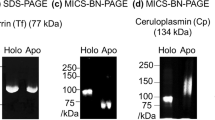Abstract
We developed a novel polyacrylamide gel electrophoresis (PAGE) method to stack and separate human hemoglobins (Hbs) based on the concept of moving reaction boundary (MRB). This differs from the classic isotachophoresis (ITP)-based stacking PAGE in the aspect of buffer composition, including the electrode buffer (pH 8.62 Tris–Gly), sample buffer (pH 6.78 Tris–Gly), and separation buffer (pH 8.52 Tris–Gly). In the MRB-PAGE system, a transient MRB was formed between alkaline electrode buffer and acidic sample buffer, being designed to move toward the anode. Hbs carried partial positive charges in the sample buffer due to its pH below pI values of Hbs, resulting in electromigrating to the cathode. Hbs would carry negative charges quickly when migrated into the alkaline electrode buffer and be transported to the anode until meeting the sample buffer again. Thus, Hbs were stacked within a MRB until the transient MRB reached the separation buffer and then separated by zone electrophoresis with molecular sieve effect of the gel. The experimental results demonstrated that there were three clear and sharp protein zones of Hbs (HbA1c, HbA0, and HbA2) in MRB-PAGE, in contrast to only one protein zone (HbA0) in ITP-PAGE for large-volume loading (≥15 μl), indicating high stacking efficiency, separation resolution, and good sensitivity of MRB-PAGE. In addition, MRB-PAGE was performed in a conventional slab PAGE device, requiring no special device. Thus, it could be widely used in separation and analysis of diluted protein in a standard laboratory.

Diagram of MRB-induced stacking in a slab PAGE. (A) arrangement of separation buffer (pH 8.01–9.55 Tris–Gly), sample buffer (pH 6.37–7.22 Tris–Gly), and electrode buffer (pH 8.21–9.05 Tris–Gly); (B) initial MRB formed between electrode and sample buffers for stacking of low-content Hbs in sample buffer under electric field; (C) MRB moving toward the anode and partly stacking of Hbs within the MRB; (D) quasi-complete stacking of Hbs via MRB closing to the separating gel; (E) separation of Hbs in a zone electrophoresis mode








Similar content being viewed by others
Abbreviations
- 2-DE:
-
Two-dimensional electrophoresis
- CHCA:
-
α-Cyano-4-hydroxycinnamic acid
- Hbs:
-
Hemoglobins
- IEF:
-
Isoelectric focusing
- MALDI-TOF MS:
-
Matrix-assisted laser desorption/ionization–time-of-flight mass spectrometry
- MRB:
-
Moving reaction boundary
- PAGE:
-
Polyacrylamide gel electrophoresis
- TEMED:
-
N, N, N′, N-Tetramethylethylenediamine
References
Raymond S, Weintraub L (1959) Science 130:711
Blas ZS, Matioli CA (1961) Medicina 21:121–129
Blas ZS, Matioli CA (1961) Medicina 21:130–134
Reysfeld RA, Lewis UJ, Williams DE (1962) Nature 195:281–283
Osuna MB, Casamayor EO (2011) Curr Microbiol 62:111–116
Coelho MB, Macedo MLR, Marangoni S, Silva DS, Cesarino I, Mazzafera P (2010) J Agric Food Chem 58:3050–3055
He Y, Ye T, Su M, Zhang C, Ribbe AE, Jiang W, Mao C (2008) Nature 452:198–201
Sultana R, Newman SF, Huang Q, Butterfield DA (2009) Methods Mol Biol 476:149–159
Ferrero S, Gillott DJ, Remorgida V, Anserini P, Leung KY, Ragni N, Grudzinskas JG (2007) J Proteome Res 6:3402–3411
Murray S, McKenzie M, Butler R, Baldwin S, Sutton K, Batey I, Timmerman-Vaughan GM (2011) Anal Biochem 413:104–113
Thaitrong N, Liu P, Briese T, Lipkin WI, Chiesl TN, Higa Y, Mathies RA (2010) Anal Chem 82:10102–10109
Ornstein L (1964) Ann NY Acad Sci 121:321–349
Davis BJ (1964) Ann NY Acad Sci 121:404–427
Zhang T, Gai Q, Qu F, Zhang Y (2011) Electrophoresis 32:2904–2910
Herr AE, Throckmorton DJ, Davenport AA, Singh AK (2005) Anal Chem 77:585–590
Hatch AV, Herr AE, Throckmorton DJ, Brennan JS, Singh AK (2006) Anal Chem 78:4976–4984
Khurana TK, Santiago JG (2008) Anal Chem 80:279–286
Persat A, Chivukula RR, Mendell JT, Santiago JG (2010) Anal Chem 82:9631–9635
Persat A, Santiago JG (2011) Anal Chem 83:2310–2316
Chen YL, Lu WJ, Chen XG, Teng M (2012) Cent Eur J Chem 10:611–638
Dodd DW, Hudson RHE (2007) Electrophoresis 28:3884–3889
Zheng CY, Ma G, Su Z (2007) Electrophoresis 28:2801–2807
Deman J, Rigole W (1970) J Phys Chem 74:1122–1126
Deman J (1970) Anal Chem 42:321–324
Cao CX, He YZ, Li M, Qian YT, Gao MF, Ge LH, Zhou SL, Yang L, Qu QS (2002) Anal Chem 74:4167–4174
Cao CX, Zhang W, Qin WH, Li S, Zhu W, Liu W (2005) Anal Chem 77:955–963
Cao CX, Fan LY, Zhang W (2008) Analyst 133:1139–1157
Zhan XQ, Guan YJ, Li C, Chen Z, Xie J, Chen P, Liang S (2002) Acta Biochim Biophys Sin 34:50–56
Xu F, Sun S, Liu X (2006) Acta Chim Sin 64:543–550
Mario N, Baudin B, Aussel C, Giboudeau J (1997) Clin Chem 43:2137–2142
Chandalia H, Krishnaswamy P (2002) Curr Sci 83:1522–1532
Hempe J, Craver R (1994) Clin Chem 40:2288–2295
Acknowledgments
The project was supplied by the NSFC (no. 21035004, 21275099), National Key Development of Scientific Instrument (no. 2011YQ030139), Key Scientific Project of Shanghai Jiao Tong University (no. YG2010ZD209), and the Instrumental Analysis Center of SJTU and the University.
Conflict of interest
The authors have declared no conflict of interest.
Author information
Authors and Affiliations
Corresponding authors
Additional information
Yun-Yun Tang, Hou-Yu Wang contributed equally to this work.
Electronic supplementary material
Below is the link to the electronic supplementary material.
ESM 1
(PDF 2.50 mb)
Rights and permissions
About this article
Cite this article
Tang, YY., Wang, HY., Chen, L. et al. Novel moving reaction boundary-induced stacking and separation of human hemoglobins in slab polyacrylamide gel electrophoresis. Anal Bioanal Chem 405, 8587–8595 (2013). https://doi.org/10.1007/s00216-013-7258-6
Received:
Revised:
Accepted:
Published:
Issue Date:
DOI: https://doi.org/10.1007/s00216-013-7258-6




